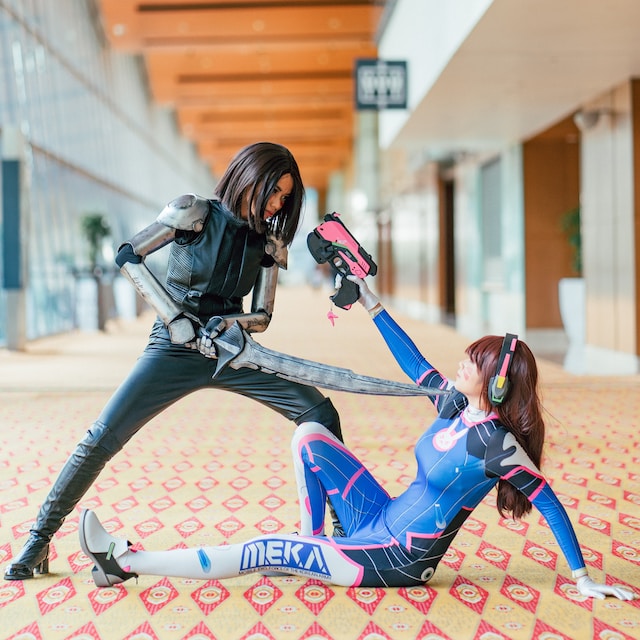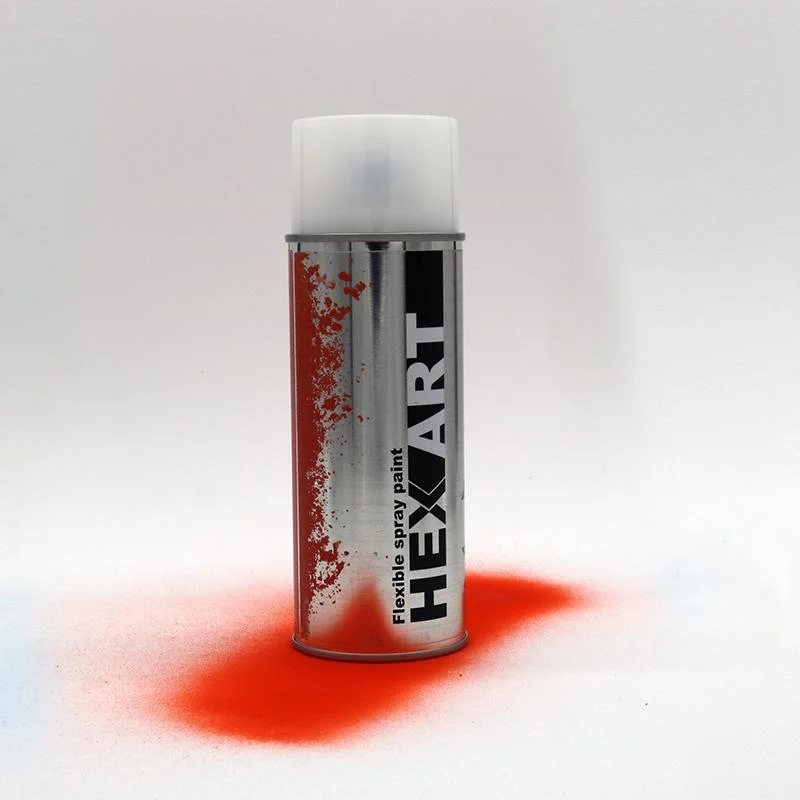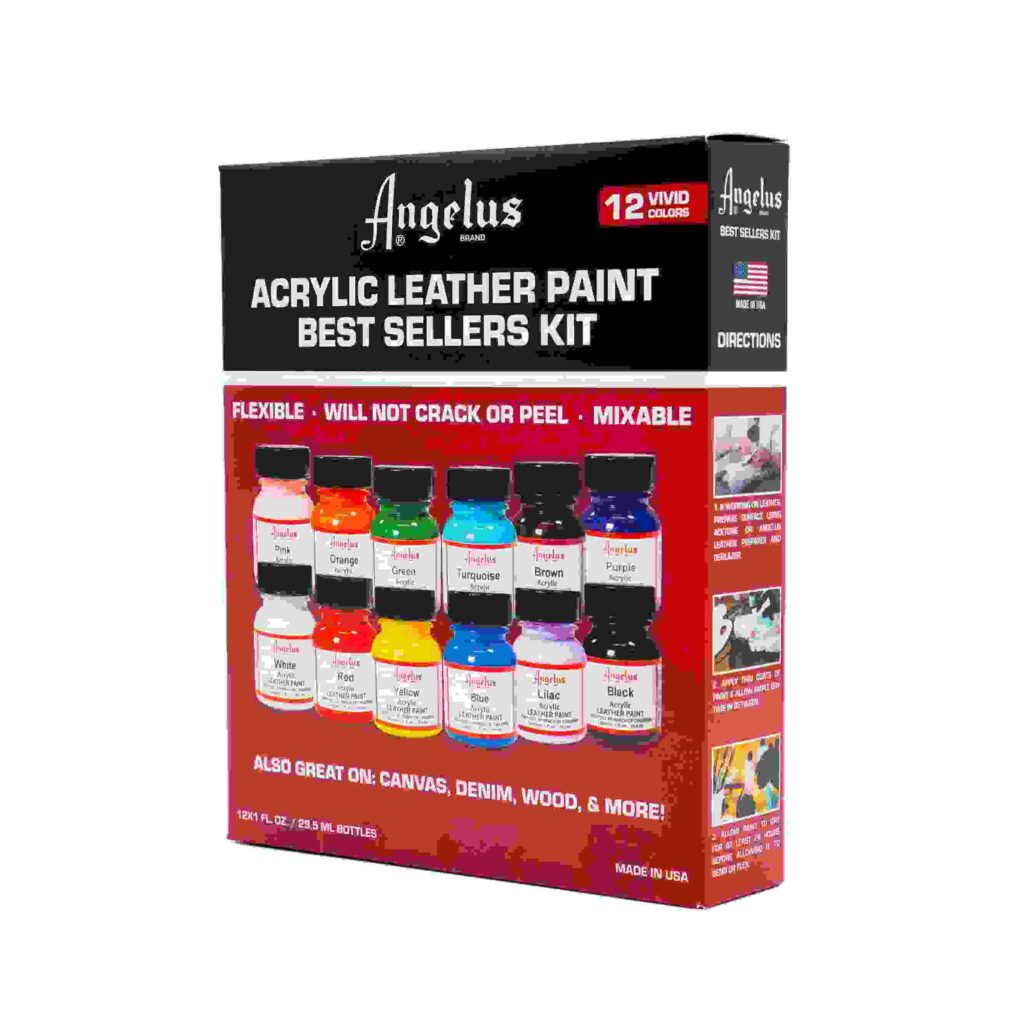Last Updated on March 12, 2024 by Masha Eretnova
Ever wondered how people make those incredible costumes and props you see at conventions or in movies?
Well, the secret ingredient is EVA foam – a fantastic flexible material that lets you bring your imagination to life. But, there’s a trick to making your foam creations look absolutely amazing: the right paint!
And to help you choose the best paint for eva foam costumes and attributes, I have this little guide.
Best choice for painting eva foam are acrylic and spray paints that will work both on swords or weapons and armor with flexibility. Good brands for painting base layers and details on eva foam are Plastidip, PlaidFX and any acrylic paint.
So, if you’ve ever dreamt of creating a superhero costume, a magical staff, or any other cool eva foam prop, you’re in the right place.
Let’s dig in!

Table of Contents
This article contains affiliate links. It means no extra cost for you but a little commission (2-3%) for me to support my hobby and blog. Thank you!
My Top-5 Best paint for eva foam
My recommendation is based on research, years of working with paint and advice from well-experienced cosplayers.
- as priming coat – Plastidip or Mod Podge or flexible primer
- as base coat – Plasti dip or Liquitex spray paint
- as final paint layer – any good quality matte or satin acrylic paint
So you actually need 2 or 3 products to paint your costume pieces the best and most efficient way.
PlastiDip – best paint for eva foam for priming and applying a base coat
Plastidip has been around for ages and it is truly the go to choice for both professional and amateur cosplayers.
It is a rubber-based coating that acts as a primer and contact adhesive and gives a solid color at the same time. The rubber base is what makes it so flexible – which is exactly what we need for eva foam armor.
That’s why we use it as the first step in painting eva foam.
It sticks to practically anything and doesn’t crack so it will be easy to achieve a smooth surface even if it’s your first use.
The major downside that now we see with plastidip is the limited color range compared to all new paints being introduced into the market.
At the same time, I think as a primer/base coat it doesn’t have to offer a bazillion of colors.
Price wise a spray can of 11 oz (311 g) is around $8 which is very affordable. Easy to buy – almost in any local hardware store.
PlaidFX Armour Flexible Paint
PlaidFX is a flexible acrylic paint that comes in stunning neon, metallic, glow-in-the-dark and regular color range.
As acrylic-based it means it dries quickly, has no odor, stays permanently on the surface of the foam and as it was designed for cosplay – it will remain flexible and won’t crack when you move.
Metallic colors are absolutely amazing.
Normally 3 oz of their paint can cover up to 7 sq f, but I would count for a few layers.
The price is another big plus as a 3oz bottle hardly costs $5 on Blick.
HexPaints

There is a big paint manufacturer Poly-Props Ltd that makes a few options for cosplayers.
All of them are a bit harder to buy as you won’t be able to find them on Amazon or Blick and they are more accessible in UK.
- HexArt high-quality, professional spray paints.
Very flexible and durable they are mainly developed to work on plastic and foams which is perfect for making a costume.
They are good choice for their metallic colors.
- HexFlex are brush-on water-based paint for fabrics and foams.
The main differences between them and HexArt is that they are brush on vs HexArt spray, HexFlex come in small pots and they have different color ranges.
Liquitex paint (Spray paint for solid thin base color/ Basics for details)
While all acrylics are water-based and versatile, not all of them stay flexible till the end on eva foam. Unfortunately many craft acrylics will look well while wet but then will crack.
The one brand of acrylics that cosplayers agree on is Liquitex. Top quality for all things painting.
And for eva foam you can use Liquitex products in 2 ways:
- Liquitex Spray paint for applying thin solid one-color base layer after your primed the foam with Plastidip or sealent. Liquitex spray paints have a nice range of 100(!) different colors. The layer will be matte which is perfect for base coat. Another big advantage is that they have less odor as they are water-based and not solvent-based. 400 ml can is around $12-13.
- Liquitex basics or professional acrylics for painting different areas and details over the color base coat you did with spray paint. They are great for brush-on application and have bold, opaque colors. You can use these paint for finishing touches and painting medium-sized areas (like shoulder piece for ex.)
Angelus Leather Paint

Angelus leather paint is the ultimate choice for painting on leather but in fact the paint will work on any textilelike surface that needs to stay flexible once painted.
They don’t peel or crack, stick permanently to foam and keep the vibrancy of colors through time (if you wear the piece a few times).
Major upside is that you can use this same paint to customize your shoes/boots for the fest as well.
The downside would be the packaging – in sets they come in small 1 oz bottles so they are definitely not for covering large areas (would be too expensive).
FYI good fabric paints will also work on foam.
Cosplayer Insights from Reddit:
Cosplayers on Reddit often recommend brands like Angelus Leather Paint for its flexibility and vibrant colors.
They also love Plasti Dip, which provides a sealing base layer before painting, preventing cracks.
On a side note I’ve seen one cosplayer mentioning Createx airbrush paints for eva foam.
To be honest I can’t recommend or not this paint as I simply haven’t used it, but while checking the reviews one of the first things that came up is that “createx sucks”.
The negative bits were about large particles, uneven coverage, clogging and less opaque paints.
Factors to Consider When Choosing Paint for EVA Foam
When it comes to painting EVA foam, a few key factors can make a huge difference in the final result.
Here’s a quick rundown of what to keep in mind:
1. Type of Paint You Can Use for EVA foam:
- Regular Acrylic Paint: Water-based and widely loved for its flexibility. It adheres well and comes in a vast array of colors. It smells less than spray paint, less toxic and less dangerous (non flammable). Acrylics can also be thinned to be sprayed or for aibrushing.
- Fabric and Leather paint: these paints were made to be flexible and good leather brands will work on craft foam as well.
- Spray Paint: You can spray paint eva foam and worbla. Spray paint ideal for larger foam surfaces, providing smooth, even coats. However, it requires proper ventilation during application as they stink!
- Lacquer or oil-based paints DO NOT work on eva foam as they can simply damage it (and they smell).
- Special paints for eva foam: simple, they were designed for eva foam and they can be airbrushed or applied with a paint brush.
The 2 most common choices are acrylic and spray paint. To choose between spray vs acrylic, check these questions:
Do you want to have visible brush strokes?
- yes/doesn’t matter – use regular paint
- no – use spray paint OR thin the paint you have for airbrushing if it’s compatible with airbrushes
Do you need to cover large area in one solid color?
- yes – spray or airbrush
- no – acrylics and a brush for small details
2. Finish Options:
- Matte Finish: Non-reflective and natural-looking. Great choice for painting eva foam costumes.
- Satin Finish: A balance between matte and glossy, offering a slight shine and easy cleaning.
- Glossy Finish: Highly reflective, adding a shiny appearance but may highlight imperfections. I do not recommend using glossy paints for eva foam.
3. Flexibility and Durability:
- Opt for paints specifically designed to be flexible. This ensures your paint won’t crack or peel as you move in the armor.
- A durable paint withstands wear and tear, making your cosplay or prop last longer. Paint should be water-resistant as well.
4. Quality vs. Price:
- Balance quality and budget. Higher-quality paints often yield better, long-lasting good results. Yet, some budget-friendly options work well for specific projects.
- Spray paints are usually a bit more expensive than acrylics.
5. Understanding the process of painting eva foam
To understand the choice of paint for painting eva foam it is important to keep in mind 3 basic steps when we customize a cosplay costume:
- First step – Priming eva foam
- Second step – Applying Base solid coat
- Third step – Applying Actual colors, painting details
- Last step – sealing the paint with a protective layer for durability.
So when we talk about picking the best performing paint, we need to specify for what step – basic layer or for details and colors.
It doesn’t really matter what paint brand you end up using for small details, but for best results priming before painting is key.
No Matter Paint, Priming Eva Foam Is Key
Imagine the sealant as the foundation upon which your entire paintwork rests; it determines the paint’s ability to stretch and move without cracking or creasing.
A common misconception is that any sealant will do, but the reality is far more nuanced and Mod Podge sealed eva foam can sometimes crack.

The flexibility of your finished product is directly linked to the flexibility of your chosen sealant.
You can use 2 types of sealants:
- spray sealer like Plasti Dip
- brush-on sealer like Mod Podge or more professional option
Best primer for painting eva foam
Spray Sealants for EVA foam:
1. Plastidip: Plasti Dip stands as the vanguard in the realm of spray sealants. Widely available in hardware and automotive stores, it offers an array of colors and provides a smooth finish without the need for extensive sanding. Its flexibility is unparalleled, making it a top choice among seasoned crafters. You can use up to 10 coats for better durability. Note that spray Plastidip dries very fast.
2. FlexSeal: Slightly pricier but equally effective, FlexSeal is another option worth considering. It is rubber-based just as Plastidip which guarantees flexibility. May be harder to find. Doesn’t come in colors.
3. Krylon Craft Foam Primer if you absolutely cannot find PlastiDip or FlexSeal or any other rubber-based foam primers, you can buy Krylon. It performs weaker than Plastidip (can melt some foams, especially styrofoam) and is less sticky and flexible. Doesn’t have color options.
Brush On Sealants for finishing Eva Foam:
1. Flexbond: When the winter chill sets in, and spray sealants become challenging to work with, Flexbond comes to the rescue. It is a glue-based primer with good flexibility and smooth coverage without brushstrokes. Works for foam and worbla.
2. Cosflex: An economical yet effective alternative, Cosflex, is a great choice for beginners. Works also for foam and worbla.
The downside of glue based primers for me is that they are clear vs Plastidip that already can act as a solid covering color base.
3. Plaid FX Clear Paint Primer – special flexible primer created for priming cosplay costumes and props made of different materials, including eva foam. Good things about this one are cheap price and the option of mixing it directly with base coat color so you sort of killing two birds at once, priming and applying base color.
4. HexFlex Acrylic Primer – affordable brush-on primer for foam that comes in a few colors so you can potentially skip the base layer of paint.
4. Cheap craft sealer like matte Mod Podge, Elmers’ glue, Wood glue (or any white glue). They are budget friendly and beginners-friendly but the offer the least durability and flexibility. So they can be better for something that doesn’t have to be flexible like weapons and small accessories for your outfits, but for clothes get Plastidip or Flexseal.
Painting Eva Foam Tips
Achieving a flawless finish on your EVA foam projects involves more than just choosing the right products.
Here are some expert tips and tricks, sourced from experienced crafters and professionals, to ensure your creations stand the test of time:
Best method many cosplayers follow: Plastidip as a base coat, Spray paint or acrylic paint over it. Seal with clear top coat.
You still have to do more sealing with an actual sealing product like plastidip or mod podge or something. On top of that, I’d say use a flat primer with a color that works with what top color you want. For example, if
1. Keep your room at the right temperature and humidity:
- Don’t work on days hotter than 90°F (32°C) or colder than 50°F (10°C). High humidity can cause issues too. Always check the labels for specific temperature ranges. Otherwise the paint will peel off, can bubble or crack.
- If working with spray paints, please wear a mask to avoid inhaling toxic fumes and keep the room weel ventilated.
2. Seal Every Surface:
- Eva foam is very absorbent, even after heat setting with a heat gun. Always use a sealant before painting even if for now you can only afford Mod Podge. Allow at least 24 hours for the sealant to cure fully.
3. Sequence Matters:
- Glue your foam pieces first, then apply sealant and paint. Doing it in this order ensures a strong bond and prevents damage to your finish.
4. Practice and Experiment:
- Test paints and sealants on small scraps of foam. Different brands react differently. Experimentation helps you understand drying times and finishes.
- Use masking tape to protect the areas you don’t want painted or to create clean edges.
5. Thin Layers and Patience Pays Off:
- Apply thin coats of paint and sealant. Allow each layer to dry for at least 1-2 hours. Patience ensures a smooth, professional look.
6. Protect Your Work:
- When attaching heavy parts, use painter’s tape on painted areas. This prevents accidental damage.
A professional cosplayer JeiCos once shared amazing color matching tips on Reddit (please watch his videos, he shares so much good tips!
Here is what he says:
- Gold looks best over red base coat/primer.
- Nice silver or chrome looks best over gloss black over any primer
- He recommends against using gloss paints
FAQ
-
Do I need to prime EVA foam before painting?
The best way to prepare eva foam for painting is to prime and seal it with Plastidip or an alternative like Mod Podge. It will seal the absorbent surface of the foam to make sure the paint sticks, stays and doesn’t crack.
-
Can I use poster paint on EVA foam?
While you can use water-based acrylic paint, I would not suggest postre paint on EVA foam as it is not water-resistant and can easily crack and flake from foam.
-
What paint to use on foam?
To paint eva foam you can use spray paint, acrylic paint, house latex paint, Angelus leather paint and special flexible paints for foam and worbla.
-
What is the non toxic paint for EVA foam?
Acrylic paints like Liquitex are a good non-toxic choice for painting EVA foam. They don’t have smell, safe to use and don’t require solvents.
Crafting is all about enjoying the process. With attention to detail and these precise steps, your EVA foam projects will be top-notch😊

Masha Eretnova, born in 1991, is a Buenos Aires-based certified teacher, artist, and member of the Professional Artist Association with 20+ years of personal painting journey.
She started painting and drawing very early and is now an international abstract artist and educator passionate about acrylic painting, gouache, and crafts.
Her works are part of international exhibitions and contests, including ArtlyMix (Brazil), Al-Tiba 9 (Spain), Exhibizone (Canada), Italy, and many more.
Besides her artistic pursuits, Masha holds a post-grad diploma in Teaching Film Photography and 2 music school diplomas: piano and opera singing.
